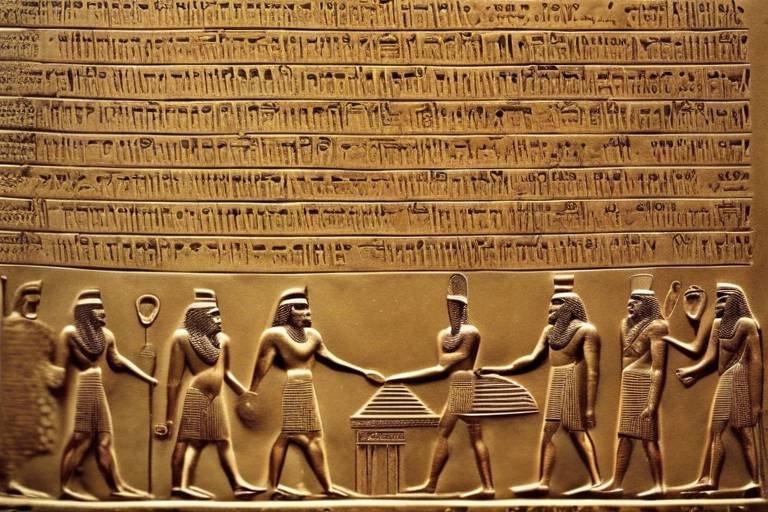The Secrets of Ancient Civilizations' Transportation Systems
Have you ever wondered how ancient civilizations managed to transport people and goods across vast distances without modern technology? The transportation systems of ancient societies hold fascinating secrets that reveal their innovative techniques and infrastructure. These methods not only enabled the movement of individuals and commodities but also played a crucial role in shaping the cultures and economies of these ancient civilizations.
From the mighty Egyptian Nile boats to the strategic Roman roads and bridges, each civilization developed unique transportation methods tailored to their geographical challenges and societal needs. The intricate design of the boats used by the ancient Egyptians on the Nile River showcased their advanced knowledge of naval architecture and water transportation methods.
The engineering marvels of Roman roads and bridges highlighted their durability and strategic construction, facilitating the expansion of the Roman Empire and efficient travel across vast territories. Incan rope bridges demonstrated sophisticated techniques employed by the Incas to navigate the rugged terrain of the Andes Mountains and connect distant regions of their empire.
The Chinese Grand Canal, one of the world's oldest and longest artificial waterways, revolutionized transportation and trade in ancient China, showcasing the innovative spirit of the Chinese civilization. Greek triremes, with their advanced maritime technology, dominated the Mediterranean Sea, revolutionizing naval warfare and transportation in the ancient world.
The Mayan causeways, Viking longships, and Persian Royal Roads each played a significant role in connecting distant regions, facilitating trade, communication, and military movements. These transportation systems not only allowed for the exchange of goods and ideas but also shaped the cultural identities and power dynamics of these ancient civilizations.
Embark on a journey through time to explore the secrets of ancient civilizations' transportation systems, marvel at their ingenuity, and discover how these innovative methods paved the way for the interconnected world we live in today.

Egyptian Nile Boats
Exploring the remarkable transportation methods used by ancient civilizations, revealing their innovative techniques and infrastructure that enabled the movement of people and goods across vast distances in historical times.
When it comes to the ancient Egyptians, their mastery extended beyond pyramids to the waters of the Nile River. Egyptian Nile boats were not just vessels; they were marvels of engineering that played a crucial role in the civilization's daily life. Crafted with precision and expertise, these boats were a symbol of the Egyptians' advanced knowledge of naval architecture.
The intricate design of the Egyptian Nile boats showcased the Egyptians' understanding of water transportation methods. These boats were not merely means of travel but also integral to the economy, trade, and cultural exchange along the Nile. Imagine gliding on the tranquil waters of the Nile aboard one of these vessels, witnessing the bustling activity and vibrant life that thrived along the riverbanks.
With sails billowing in the wind and oars slicing through the water, Egyptian Nile boats navigated the river with grace and efficiency. The ancient Egyptians' reliance on these boats for transportation highlights the significance of the Nile River as the lifeblood of their civilization. These boats were not just wooden structures; they were vessels of history, carrying the stories and secrets of a civilization that flourished along the banks of the mighty Nile.

Roman Roads and Bridges
Roman Roads and Bridges were marvels of engineering in ancient times, showcasing the ingenuity and strategic vision of the Roman Empire. These roads, known as "viae," were meticulously constructed with layers of gravel, sand, and stones, ensuring durability and longevity. The Roman engineers utilized advanced techniques such as embankments, cuttings, and bridges to overcome various terrains and obstacles, facilitating efficient travel and communication across the vast expanse of the empire.
One of the most famous Roman roads, the Appian Way, connected Rome to the southern regions of Italy, serving as a vital artery for military movements, trade, and cultural exchange. The bridges built by the Romans were architectural masterpieces, such as the Pont du Gard in France, showcasing their expertise in aqueduct construction and water management.
These roads and bridges not only linked distant provinces but also played a crucial role in the expansion and governance of the Roman Empire. They enabled the swift movement of troops, officials, and goods, fostering unity and cohesion across the vast territories under Roman rule.

Incan Rope Bridges
Exploring the remarkable transportation methods used by ancient civilizations, revealing their innovative techniques and infrastructure that enabled the movement of people and goods across vast distances in historical times.
Discover the intricate design and significance of the boats used by the ancient Egyptians on the Nile River, showcasing their advanced knowledge of naval architecture and water transportation methods.
Uncover the engineering marvels of Roman roads and bridges, highlighting their durability and strategic construction that facilitated the expansion of the Roman Empire and efficient travel across vast territories.
Delve into the unique construction of Incan rope bridges, showcasing the sophisticated techniques employed by the Incas to navigate the rugged terrain of the Andes Mountains and connect distant regions of their empire.
Explore the history and significance of the Chinese Grand Canal, one of the world's oldest and longest artificial waterways, illustrating how this engineering feat revolutionized transportation and trade in ancient China.
Examine the military and transportation prowess of Greek triremes, ancient warships equipped with three rows of oars, revolutionizing naval warfare and enabling the Greeks to dominate the Mediterranean Sea with their advanced maritime technology.
Unearth the secrets of Mayan causeways, elevated roads constructed by the Maya civilization to traverse dense jungles and connect their urban centers, showcasing their ingenuity in overcoming geographical challenges for transportation.
Embark on a journey through the history of Viking longships, agile and sturdy vessels that allowed the Norse seafarers to explore, raid, and trade across vast distances, shaping the maritime culture of the Viking Age.
Investigate the strategic network of Persian Royal Roads, an ancient highway system established by the Achaemenid Empire, facilitating swift communication, trade, and military movements across the vast territories of the Persian Empire.
The Incan rope bridges were a remarkable feat of engineering, allowing the Incas to traverse the challenging terrain of the Andes Mountains with ease. These bridges, made from woven fibers such as grass and vines, showcased the ingenuity of the Incan civilization in adapting to their environment. Despite their simple appearance, these rope bridges were strong and reliable, enabling safe passage over deep gorges and swift rivers. The construction of these bridges required precise knowledge of natural materials and structural integrity, reflecting the advanced skills of the Incan builders.
Stay tuned for answers to common questions about ancient civilizations' transportation systems and their fascinating innovations.

Chinese Grand Canal
The stands as a testament to ancient engineering ingenuity and the enduring legacy of Chinese civilization. Stretching over 1,100 miles, this monumental waterway connected the Yellow River and Yangtze River, serving as a vital artery for transportation and trade in ancient China. Constructed over multiple dynasties, the Grand Canal showcased the remarkable organizational skills and labor force of the Chinese people, who dug canals, built locks, and constructed bridges to link major cities and regions.
One of the most impressive features of the Chinese Grand Canal was its sheer scale and strategic importance. By linking the north and south of China, the canal facilitated the efficient movement of goods such as rice, silk, and tea, contributing to economic growth and cultural exchange between different regions. The canal also played a crucial role in the transportation of troops and supplies, enabling swift military mobilization and communication during times of conflict or political unrest.
Moreover, the Chinese Grand Canal not only served practical purposes but also symbolized the unity and power of the Chinese state. Its construction required meticulous planning and coordination, involving thousands of laborers and engineers who worked tirelessly to overcome natural obstacles and ensure the canal's smooth operation. The Grand Canal became a symbol of imperial authority and technological advancement, reflecting China's status as a sophisticated and advanced civilization in the ancient world.
Furthermore, the Chinese Grand Canal had a profound impact on the social and cultural life of the people living along its banks. The bustling water traffic and vibrant trade hubs that emerged along the canal fostered economic prosperity and cultural exchange, shaping the development of cities and communities along its route. The canal became a lifeline for millions of people, providing a means of livelihood and connection to distant lands, enriching the tapestry of Chinese society with diverse influences and opportunities.
In conclusion, the Chinese Grand Canal stands as a remarkable achievement of ancient engineering and a testament to the enduring legacy of Chinese civilization. Its impact on transportation, trade, and cultural exchange reverberated through the centuries, shaping the history and identity of China as a nation. The Grand Canal remains a symbol of human innovation and perseverance, showcasing the remarkable feats that ancient civilizations were capable of accomplishing.

Greek Triremes
Exploring the remarkable transportation methods used by ancient civilizations, revealing their innovative techniques and infrastructure that enabled the movement of people and goods across vast distances in historical times.
Discover the intricate design and significance of the boats used by the ancient Egyptians on the Nile River, showcasing their advanced knowledge of naval architecture and water transportation methods.
Uncover the engineering marvels of Roman roads and bridges, highlighting their durability and strategic construction that facilitated the expansion of the Roman Empire and efficient travel across vast territories.
Delve into the unique construction of Incan rope bridges, showcasing the sophisticated techniques employed by the Incas to navigate the rugged terrain of the Andes Mountains and connect distant regions of their empire.
Explore the history and significance of the Chinese Grand Canal, one of the world's oldest and longest artificial waterways, illustrating how this engineering feat revolutionized transportation and trade in ancient China.
Examine the military and transportation prowess of Greek triremes, ancient warships equipped with three rows of oars, revolutionizing naval warfare and enabling the Greeks to dominate the Mediterranean Sea with their advanced maritime technology.
Unearth the secrets of Mayan causeways, elevated roads constructed by the Maya civilization to traverse dense jungles and connect their urban centers, showcasing their ingenuity in overcoming geographical challenges for transportation.
Embark on a journey through the history of Viking longships, agile and sturdy vessels that allowed the Norse seafarers to explore, raid, and trade across vast distances, shaping the maritime culture of the Viking Age.
Investigate the strategic network of Persian Royal Roads, an ancient highway system established by the Achaemenid Empire, facilitating swift communication, trade, and military movements across the vast territories of the Persian Empire.

Mayan Causeways
Exploring the remarkable transportation methods used by ancient civilizations, revealing their innovative techniques and infrastructure that enabled the movement of people and goods across vast distances in historical times.
Deep within the lush jungles of Mesoamerica, the Mayan civilization crafted a network of causeways that defied the challenging terrain and connected their bustling urban centers. These causeways, elevated roads raised above the dense foliage, served as vital arteries for transportation and trade, showcasing the Mayan ingenuity in overcoming geographical obstacles. The intricate system of causeways allowed the Mayans to navigate through the rugged landscape, facilitating the movement of goods, people, and ideas across their expansive territory.

Viking Longships
Exploring the remarkable transportation methods used by ancient civilizations, revealing their innovative techniques and infrastructure that enabled the movement of people and goods across vast distances in historical times.
Viking longships were agile and sturdy vessels that played a crucial role in shaping the maritime culture of the Viking Age. These ships were not merely means of transportation but symbols of exploration, raiding, and trade for the Norse seafarers. Crafted with exceptional craftsmanship, Viking longships were designed to navigate both open seas and shallow rivers, allowing the Vikings to reach distant lands and establish their dominance in the maritime world.
The design of Viking longships was revolutionary for their time, featuring a sleek and streamlined hull that enabled swift movement through water. Equipped with both sails and oars, these ships were versatile and could adapt to various navigational conditions, making them formidable vessels for long-distance journeys. The shallow draft of the longships allowed them to approach shorelines that were inaccessible to larger vessels, granting the Vikings a strategic advantage in coastal raids and explorations.
One of the most iconic features of Viking longships was their dragon-headed prows, which not only served as intimidating symbols of power but also had practical functions in battle. These elaborately carved figureheads instilled fear in enemies and boosted the morale of the Viking warriors, enhancing their reputation as fierce seafarers. The combination of speed, maneuverability, and striking visual aesthetics made Viking longships the epitome of maritime prowess during the Viking Age.
With their ability to traverse vast distances, Viking longships facilitated the expansion of the Norse influence across Europe and beyond. These ships were instrumental in establishing trade routes, conducting raids on foreign shores, and exploring new territories, laying the foundation for the Viking legacy that continues to captivate the imagination of historians and enthusiasts today.
1. Were Viking longships only used for warfare?
2. How were Viking longships constructed and what materials were used?
3. What role did Viking longships play in the exploration of North America?
4. Did Viking longships have any specific navigational innovations?
5. How did the design of Viking longships contribute to their success in maritime activities?

Persian Royal Roads
The were a sophisticated network of highways constructed by the Achaemenid Empire, known for their strategic importance in facilitating swift communication, trade, and military movements across the vast territories of the Persian Empire. These roads, built during the reign of King Darius I, connected major cities such as Susa, Babylon, and Sardis, stretching over 2,500 kilometers from the Aegean Sea to the Persian Gulf.
The construction of the Persian Royal Roads was a monumental engineering achievement, utilizing advanced techniques for road building and maintenance. These well-maintained highways featured rest stations, known as "caravanserais," where travelers could find shelter, food, and fresh horses for efficient long-distance travel. The roads were patrolled by the imperial courier service, ensuring the safe and timely delivery of messages and goods.
One of the most remarkable aspects of the Persian Royal Roads was their role in fostering cultural exchange and diplomatic relations between different regions of the empire. Merchants, diplomats, and messengers traveled along these roads, facilitating the exchange of ideas, technologies, and commodities that contributed to the prosperity and stability of the Persian Empire.
The strategic significance of the Persian Royal Roads extended beyond mere transportation, as they played a crucial role in the military campaigns of the Achaemenid Empire. The rapid mobilization of troops and supplies along these well-connected highways enabled the Persian rulers to assert their authority and expand their influence over vast territories, from the heart of Persia to the distant frontiers of the empire.
In conclusion, the Persian Royal Roads stand as a testament to the ingenuity and organizational prowess of the ancient Persians, demonstrating their ability to overcome geographical challenges and establish a sophisticated network of transportation infrastructure that shaped the political, economic, and cultural landscape of the Persian Empire.
Frequently Asked Questions
- What were the main modes of transportation used by ancient civilizations?
Ancient civilizations utilized various modes of transportation, including boats, roads, bridges, and causeways, tailored to their geographical and infrastructural needs.
- How did the transportation systems of ancient civilizations contribute to their societal development?
The transportation systems of ancient civilizations played a crucial role in facilitating trade, communication, and cultural exchange, leading to economic growth and the expansion of empires.
- What technological advancements were evident in the transportation methods of ancient civilizations?
Ancient civilizations demonstrated remarkable technological advancements in transportation, such as advanced naval architecture, innovative road construction, and sophisticated bridge engineering.
- Why were transportation networks essential for the prosperity of ancient societies?
Transportation networks were vital for connecting distant regions, enabling the efficient movement of goods and people, fostering economic prosperity, and enhancing military capabilities.



















